Premo New Technology Reduces Emitter Antennae Length by 50% for Automotive Electronics.
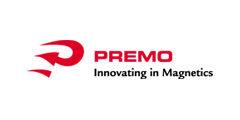
The Diabolo™ Core Patented Technology for Emitter Antennae in Car Keyless Entry Systems developed by PREMO spares space and allows shorter and more robust devices.
Automotive Passive Keyless Systems ( Fig 1) are growing in global market penetration. By 2025 more than 25% of newly-assembled light vehicles are forecasted to have a Keyless Entry system. A global production that is more than 30M systems per year. Market demand for better performance in terms of longer reading range, less energy consumption, smaller size, and component count and costs is leading to systems with fewer antennae ( 3 instead of 5) but necessarily, the antennas must be longer to generate larger fields equivalent to the radiation pattern of 5 antennae. Premo has developed 2 alternatives:
Longer flexible antennas based on Alma™ Technology for Mid-Range and Long Range or the new Diabolo™ technology generates the same magnetic field that long brittle conventional single-core ferrite antennas with 50% shorter length and improving mechanical resistance and reliability.
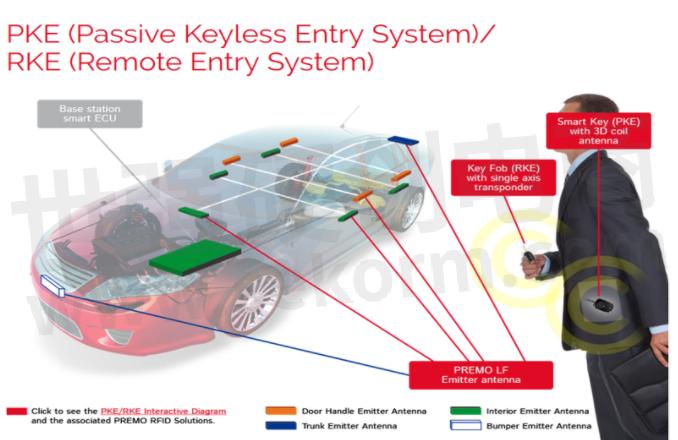
Fig.1
Passive Keyless Entry system is a generic term for automotive technology which allows a driver to lock and unlock a vehicle without using the corresponding key fob buttons. Once a driver enters a vehicle with an equipped PKE or Keyless Go keyfob (or cardkey), they have the ability to start and stop the engine, without inserting the Smart Key. A transponder antenna built within the key fob allows the vehicle to identify a driver. The SMD components located in the smart key are required high levels of sensitivity, good temperature stability, and robustness against mechanical shocks and drops.
The system works ( Fid 2) by having a series of LF (low frequency 125 kHz) transmitting antennas both inside and outside the vehicle. The external antennas are located in the door handles, mirrors, or trunk position.
The system works ( Fid 2) by having a series of LF (low frequency 125 kHz) transmitting antennas both inside and outside the vehicle. The external antennas are located in the door handles, mirrors, or trunk position.
There are two clear areas, the Car side, and the Keyfob side. Current technology trends push the car side to reduce the component count so that fewer antennas are needed and to improve the performance to move from 4-5 short-range antennas to 3 Mid-range antennas and ultimately to 2-1
Long Range Antennas

Fig.2
PKE/KGO/KES Systems work by having a series of LF (low frequency, 20kHz, 125kHz & 134kHz) transmitter antennas, depending on chip-set used, both inside and outside the vehicle. External antennas are located in the door handler, mirrors, or trunk position. When a vehicle is triggered either, close to the vehicle, pulling the handle, or touching it an LF signal is transmitted from the antennas to the Key. Key is activated and transmitted its ID back to the vehicle using RF channel, if Keycode is correct the electronic module unlocks the vehicle.
The antennas typically have to meet the AEC-Q200 (specific automotive quality standard) and waterproof specs from IP54 to IP69K standards due to their specific packaging (a rugged plastic box filled with polyurethane foam, PA LPM protection, Epoxy coatings, or over-molding or HPM in PBT GF30 for IP69K).
According to the introduction, Mid-range antennas are longer than Short-Range antennas and Long-range antennas are even longer than Mid-range antennae ( Fig3 ).
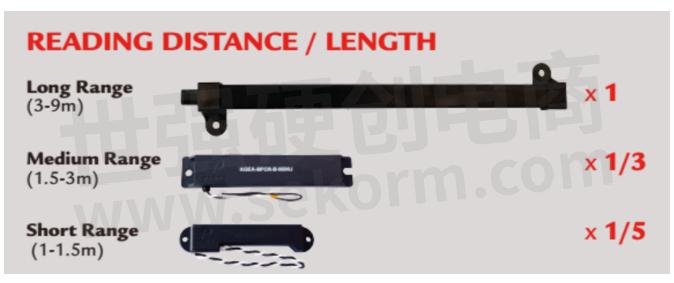
Fig.3
1.Longer devices have obvious advantages:
- Longer range
- Lower component count thus
- Higher System reliability
- Lower total system cost.
2.Nevertheless, because of the intrinsic brittleness of ferrites, longer antennae need longer cores that have several drawbacks:
- Very brittle.
- Very poor thermal stability
- Reduced Mechanical performance:
- Very poor bending resistance
- Very Poor torsion resistance
3.Because of this, there are costs and manufacturability challenges:
- Long ferrite cores production becomes critical because of a “banana effect” during the shrinkage in the sintering process.
- Small contraction and dilatation of a high L/D ratio make a high impact on effective magnetic permeability thus producing a lack of stability of L and SRF parameters over a temperature range.
- Mechanical protection of the core with plastic housings and or resins becomes costly and critical as combined thermal coefficients are critical.
- Manufacturing costs soar as the tools and molds are much bigger and complex (higher Capex) while throughput is lower than in smaller parts because of the brittleness and lower mechanical resistance.
The cost of materials, and the process is then much higher thus reducing the advantage of a lower component count per vehicle.
The logic of a lower total system costs by using fewer antennas is spoiled if those antennas cost is much higher than their short-range equivalents. Therefore, the technical challenge is achieving all the advantages of Mid-range and Long-range antennas without the above-mentioned drawbacks of brittleness, costly materials, processes and investments, and critical temperature and mechanical performance.
I a short sentence Diabolo ™ Antennas stand for: All the good features of Mid-Range antennas while preserving and keeping all the good features of the short-range antennas (cost-effective, mechanically robust, and thermally stable).
Premo innovation consists of using a Core with a Variable Cross-Sectional area that is maximum at both extremes of the antenna and minimum at the center of the antenna where the winding is located.
For a constant H field, induction B is proportional to the density of magnetic field lines and the effective magnetic permeability of the material. For the same magnetic material and the same number of turns (identical winding N = constant), the induction B in a portion of the core with half the cross-sectional area is double. Thus, a decreasing section core would concentrate magnetic field to maximize induction B at the point where cross-sectional areas are minimum.
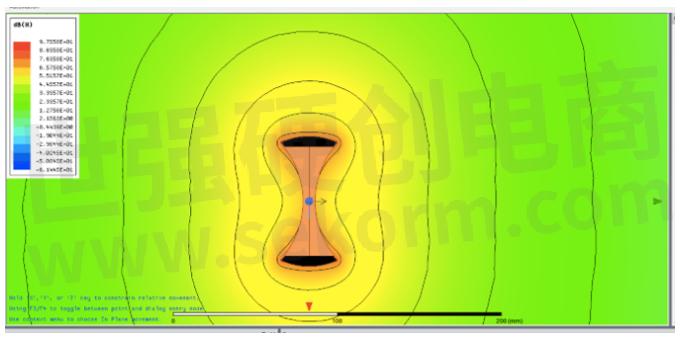
Fig.4
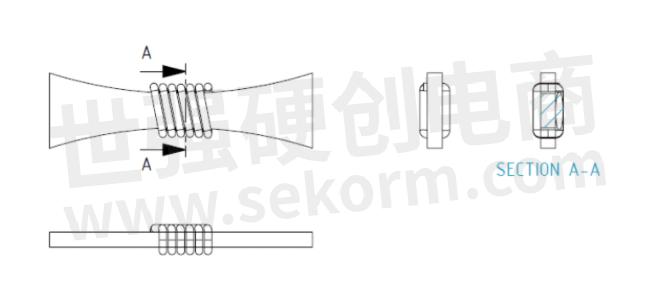
Fig.5
A simple approach is a single core that has a constant reduction of section up to 50% and a winding of N turns in the center at the point with the lowest Cross-Sectional area like in Fig 5
For an external magnetic field H and given the same effective magnetic permeability of the core, the Magnetic Flux φ through the core is constant and the induction at every point is B= φ/S being S the cross-sectional area perpendicular to the flux.
In the shape of figure 5 and Fig 6 in the following shapes the induction B at the narrowest point is double that the one at the widest.
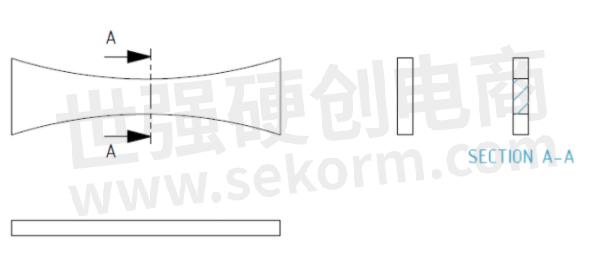
Fig.6
A larger cross-sectional area can be presented to the external H field, then increasing the Magnetic Flux φ through the core when a radius R is given like in FIG 6 in order to guide the maximum number of field lines through our low Reluctance Path that is the core.

Fig.7
The invention of cross-sectional area reduction in emitter antennas has a significant advantage in Mid-Range antennas as a similar range, induction, sensitivity, size, and cost can be achieved when compared to the prior art mid-range antennas.
A logic evolution from a constant height core is a 3D core that can present a constant reduction of the cross-sectional area including a reduction of height like in Fig 7
A graphic representation of the effect of concentration of field lines when the Magnetic Flux φ is constant along the core can be seen in FIG 4.
The effect of magnetic amplification has been described as the improvement of effective permeability (µr) of apparent permeability (µapp) considered as the ratio between the internal flux density in the core (Bn) and the external flux density (Bext)

Being µr the relative permeability of the core and Nz the demagnetizing field factor.
As knowing this Nz factor is difficult, for a given shape there are empirical formulas charts, and abacus. In the case of a rod (a pure cylindric shape) we introduced already the L/D empirical chart (courtesy of Ferroxcube):
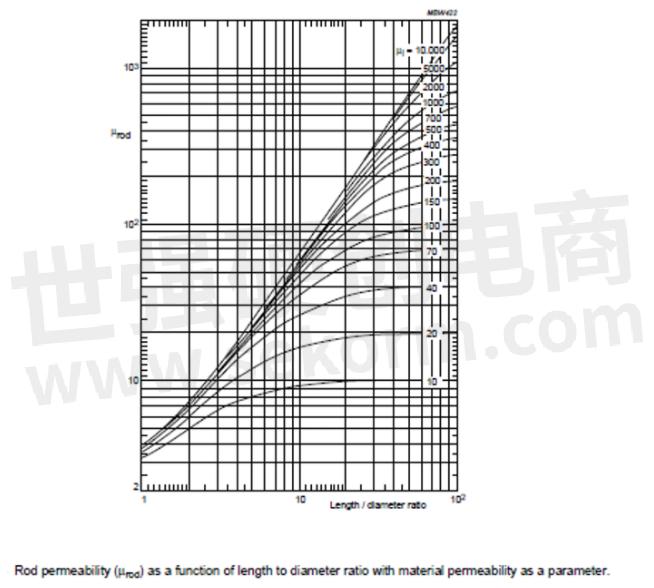
A simplified equation for the demagnetizing factor in direction z (longitudinal) is:

The graphic representation for a rod is the already mentioned graph.
Magnetic concentration of a Diabolo™ shape core with D the larger diameter, d the smaller diameter and µr the relative magnetic permeability of the core, the apparent permeability µapp will be:

In summary, the greater the ratio L/D and the larger the ratio d/D the better.
An optimized embodiment of the core that presents a progressive cross-section reduction and a maximum surface on both sides of the core is as per Figure 8.
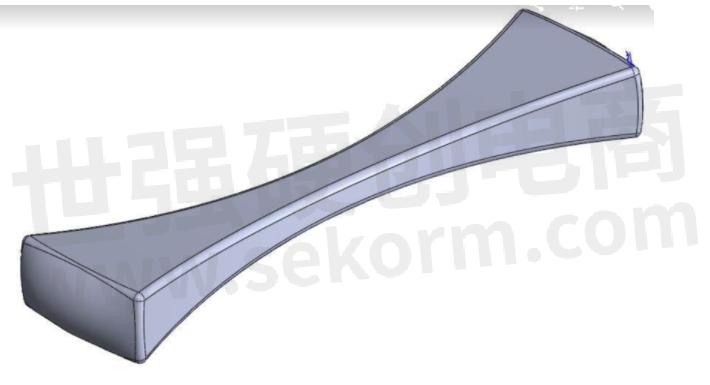
Fig.8
Fig 9 shape simulation shows the much higher induction ( red ) in the minimum section area:
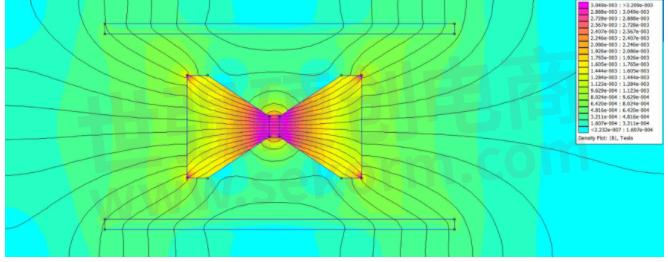
Fig.9
Long Flexible antennas Like Premo Alma ™ Technology AF series described in patent EP3333 860A1 can be made with this invention also, including echelons/links as per following figure 10 :
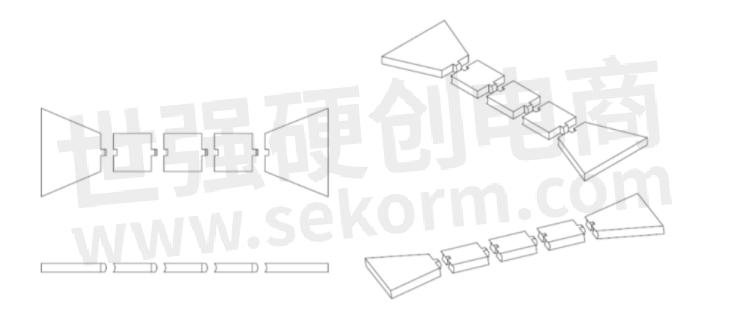
Fig.10
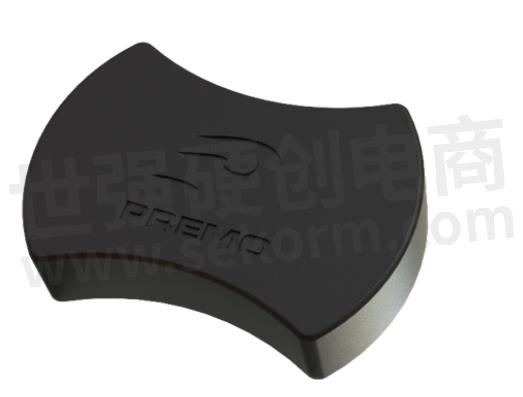
Image.1
Image 1 shows a real off tool Diabolo ™ Antenna that is 60mm or 50% shorter than Premo Conventional KGA mid-range conventional antenna ( Image 2):
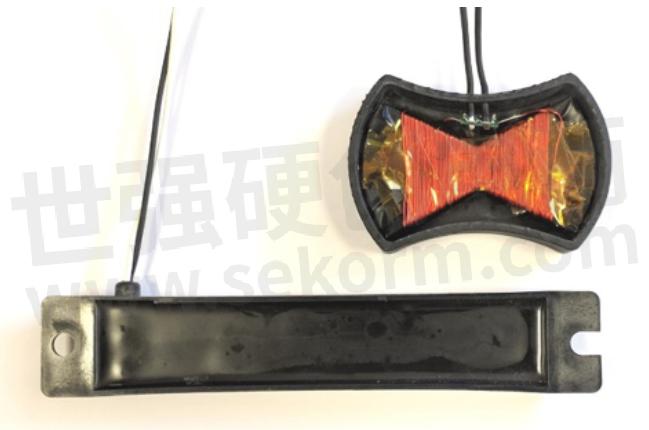
Image 2
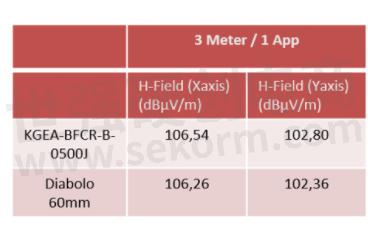
Table 1 shows H magnetic fields generated at 3m by identical excitation currents.
The invention solves the technical challenges in the following way. All the good features of Mid-Range antennas while preserving and keeping all the good features of the short-range antennas (cost-effective, mechanically robust, and thermally stable)
●Good features of Mid-Range Antennas
■Long-range
■The invention generates the same magnetic field as a Mid and long-range antenna in a smaller size.
■Lower component count
■The same number of devices can be installed per vehicle
■Lower Assembly cost
■A lower number of devices to be installed means lower assembly time and assembly costs.
●Good Features of Short- Range antennas
■Cost-Effective: the invention has a lower cost (target accomplished) than a Mid Range antenna:
■Less Ferrite
■Less Copper wire due to lower N value to achieve same inductance L
■Smaller plastic housing and less potting/ coating / encapsulating materials to secure waterproof
●Mechanically Robust
■A shorter device with a lower L/D ratio withstands bending, torsion and flexion better.
●Thermally stable
A shorter core produces smaller absolute changes in dimension with temperature. Contractions and dilatations affect less to the change of shape. The effect is minimized when the L/D ratio is lower as the changes in effective permeability due to changes in L/D with temperature expansions are lower.
An embodiment with progressive reduction of core Width and Height.
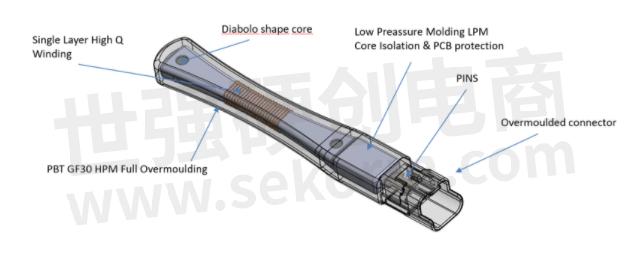
Comparison results of a 124x 6.5x 3 Mid-Range core vs an 80x8x 29/6 Diabolo ™ core of identical MnZn Material.
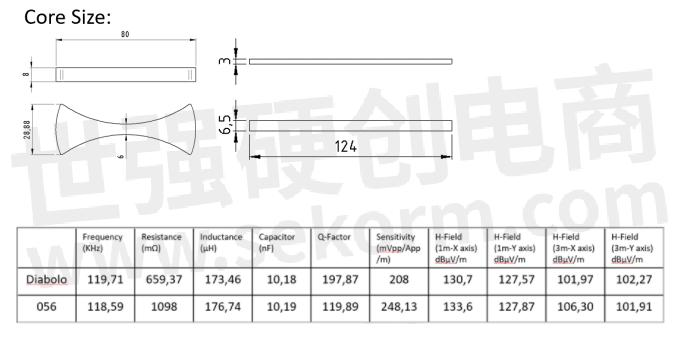
Measuring H Field at 1meters and 3meters the 40% shorter Diabolo™ core presents similar values and a much higher Q factor due to its higher effective permeability and lower number of turns thus lower DC Resistance.
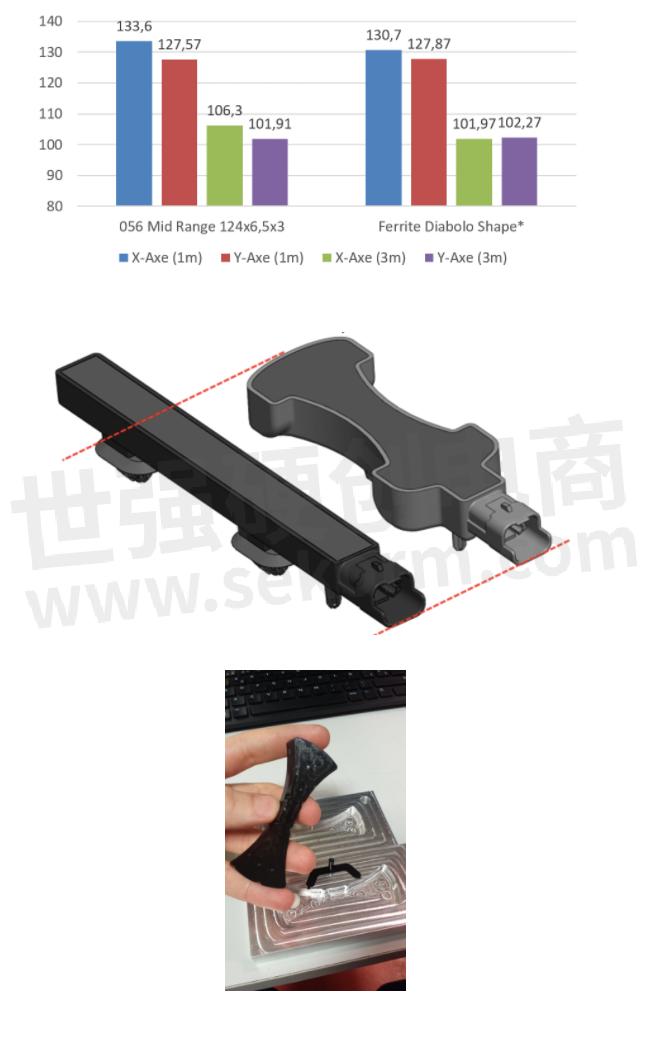
- +1 Like
- Add to Favorites
Recommend
- Premo Nanotech Magnetic Materials Allow Long Flexible Emitter Antennae for Automotive Electronics
- Receiver Antennae (Secondary Coil) That Provides Super High Efficiency (above 95%) Power Transfer | PREMO
- Do 4g Industrial Router Emit Radiation?
- Vincotech MiniSKiiP® PIM 2 IGBT M7 with Open Emitter that Enable Accurate and Cost-effective Current Measurements
- PREMO Releases New Passive Keyless Entry Providing up to 5 times More H-field than Standard Antennas
- Unleashing the Power of LEDs: A Comprehensive Guide to the LED Power Series
- Coherent Introduces 905nm Pulsed Triple-Junction Edge-Emitting Lasers for LiDAR in industrial applications
- PREMO Launches the Pushbutton Switches, the Most Innovative for Automotive and Harsh Environment
This document is provided by Sekorm Platform for VIP exclusive service. The copyright is owned by Sekorm. Without authorization, any medias, websites or individual are not allowed to reprint. When authorizing the reprint, the link of www.sekorm.com must be indicated.





























































































































































































































































































































































































































































































































































































































































































































































































































































































